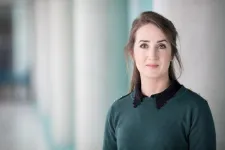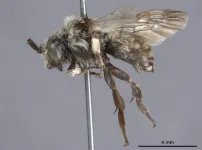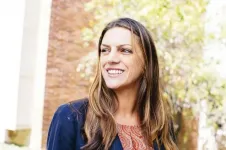(Press-News.org) A tickle in the nose can help trigger a sneeze, expelling irritants and disease-causing pathogens. But the cellular pathways that control the sneeze reflex go far beyond the sinuses and have been poorly understood. Now, a team led by researchers at Washington University School of Medicine in St. Louis has identified, in mice, specific cells and proteins that control the sneeze reflex.
"Better understanding what causes us to sneeze -- specifically how neurons behave in response to allergens and viruses -- may point to treatments capable of slowing the spread of infectious respiratory diseases via sneezes," said Qin Liu, PhD, an associate professor of anesthesiology and the study's senior investigator.
The findings are published June 15 in the journal Cell.
"We study the neural mechanism behind sneezing because so many people, including members of my own family, sneeze because of problems such as seasonal allergies and viral infections," said Liu, a researcher in the university's Center for the Study of Itch and Sensory Disorders. "Our goal is to understand how neurons behave in response to allergies and viral infections, including how they contribute to itchy eyes, sneezing and other symptoms. Our recent studies have uncovered links between nerve cells and other systems that could help in the development of treatments for sneezing and for fighting infectious respiratory diseases."
Sneezing is the most forceful and common way to spread infectious droplets from respiratory infections. Scientists first identified a sneeze-evoking region in the central nervous system more than 20 years ago, but little has been understood regarding how the sneeze reflex works at the cellular and molecular level.
In the new study, Liu and her team established a mouse model in an attempt to identify which nerve cells send signals that make mice sneeze. The researchers exposed the mice to aerosolized droplets containing either histamine or capsaicin, a pungent compound made from chili peppers. Both elicited sneezes from the mice, as they do in people.
By examining nerve cells that already were known to react to capsaicin, Liu's team was able to identify a class of small neurons linked to sneezing that was caused by that substance. The researchers then looked for molecules -- called neuropeptides -- that could transmit sneeze signals to those nerve cells, and found that a molecule called neuromedin B (NMB) was required for sneezing.
Conversely, when they eliminated the NMD-sensitive neurons in the part of the nervous system that evoked sneezes in the mice, they blocked the sneeze reflex. Those neurons all make a protein called the neuromedin B receptor. In mice without that receptor, sneezing again was greatly reduced.
"Interestingly, none of these sneeze-evoking neurons were housed in any of the known regions of the brainstem linked to breathing and respiration," Liu said. "Although we found that sneeze-evoking cells are in a different region of the brain than the region that controls breathing, we also found that the cells in those two regions were directly connected via their axons, the wiring of nerve cells."
The researchers also found they could stimulate the sneeze reflex by exposing part of the mouse brain to the NMB peptide. Further, the animals began to sneeze even though they had not been exposed to any capsaicin, histamine or other allergens.
Because many viruses and other pathogens -- including the majority of human rhinoviruses and coronaviruses such as Middle East respiratory syndrome coronavirus (MERS-CoV) and SARS-CoV-2, the coronavirus that causes COVID-19 -- are spread in part by aerosolized droplets, Liu said it may be possible to limit the spread of those pathogens by targeting NMB or its receptor to limit sneezing in those known to be infected.
"A sneeze can create 20,000 virus-containing droplets that can stay in the air for up to 10 minutes," Liu explained. "By contrast, a cough produces closer to 3,000 droplets, or about the same number produced by talking for a few minutes. To prevent future viral outbreaks and help treat pathological sneezing caused by allergens, it will be important to understand the pathways that cause sneezing in order to block them. By identifying neurons that mediate the sneeze reflex, as well as neuropeptides that activate these neurons, we have discovered targets that could lead to treatments for pathological sneezing or strategies for limiting the spread of infections."
INFORMATION:
Li F, et al. Sneezing reflex is mediated by a peptidergic pathway from nasal sensory neurons to brainstem respiratory neurons. Cell, published online June 15, 2021.
This work was supported by the National Institute of Allergy and Infectious Diseases, the National Institute of Arthritis and Musculoskeletal and Skin Diseases, and the National Eye Institute of the National Institutes of Health (NIH). Grant numbers R01 AI125743, R01 EY024702, K08 AR065577, R01 AR07116, and R01 AR77007. Additional funding was provided by the Pew Scholar Research Award, the American Skin Association and the Doris Duke Charitable Foundation.
Washington University School of Medicine's 1,500 faculty physicians also are the medical staff of Barnes-Jewish and St. Louis Children's hospitals. The School of Medicine is a leader in medical research, teaching and patient care, consistently ranking among the top medical schools in the nation by U.S. News & World Report. Through its affiliations with Barnes-Jewish and St. Louis Children's hospitals, the School of Medicine is linked to BJC HealthCare.
Research led by the University of Kent and the STFC Rutherford Appleton Laboratory has resulted in the discovery of a new rare topological superconductor, LaPt3P. This discovery may be of huge importance to the future operations of quantum computers.
Superconductors are vital materials able to conduct electricity without any resistance when cooled below a certain temperature, making them highly desirable in a society needing to reduce its energy consumption.
Superconductors manifest quantum properties on the scale of everyday objects, making them highly attractive candidates for building computers which use quantum physics to store data ...
In the heart there are two different subtypes of beta-adrenergic receptors - beta1 and beta2 - which are activated by the stress hormones adrenaline and noradrenaline. They both trigger the strongest stimulation of the heart rate and pumping capacity that we know of. The two subtypes are highly similar biochemically, but differ substantially in terms of their functional and therapeutic relevance.
Both receptor types can stimulate the heart in the short term, yet when the beta1 receptor is activated over a prolonged period of time, it has a range ...
DUBLIN, June 15, 2021 - Scientists have identified how and why some Covid-19 patients can develop life-threatening clots, which could lead to targeted therapies that prevent this from happening.
The work, led by researchers from RCSI University of Medicine and Health Sciences, is published in the END ...
A new antibody testing study examining samples originally collected through the National Institutes of Health's All of Us Research Program found evidence of SARS-CoV-2 infections in five states earlier than had initially been reported. These findings were published in the journal Clinical Infectious Diseases. The results expand on findings from a Centers for Disease Control and Prevention study that suggested SARS-CoV-2, the virus that causes COVID-19, was present in the U.S. as far back as December 2019.
In the All of Us study, researchers analyzed more than 24,000 stored blood samples contributed ...
Chemotherapy kills tumour cells by causing damage to them. One of the most effective ways of causing damage is to prevent the two DNA strands from separating so that the cellular machinery cannot read the instructions written in the genes. But sometimes, the cell manages to repair the damage and survive, evading the effect of chemotherapy. CNIO researchers have found out how the cell does that and plan to use this knowledge to enhance cancer treatments.
The key lies in a peculiar protein called PrimPol, as explained in a publication in The EMBO Journal by the CNIO's DNA Replication Group, led by Juan Méndez.
The DNA molecule harbours the genes that direct the life of the cell and, ...
The University of Ottawa has been awarded four new Canada Research Chairs (CRC) that will strengthen its expertise in artificial intelligence, health and law. The University is also proud to announce the renewal of two CRCs that will conduct leading-edge research in quantum communications and photonics.
"The Canada Research Chairs Program provides invaluable support to our researchers as they forge their paths of discovery at a world-class level," said Sylvain Charbonneau, vice-president, research. "The results of this most recent competition will ...
A review of more than 9,000 U.S. patients with severe COVID-19 infection showed less than 1% contracted the illness again, with an average reinfection time of 3.5 months after an initial positive test. Those are the findings from a study conducted by researchers from the University of Missouri School of Medicine and MU Health Care.
The researchers teamed up with the MU Institute for Data Science and Informatics and the Tiger Institute for Health Innovation to review data from 62 U.S. health care facilities. They found 63 of the 9,119 patients (0.7%) with severe COVID-19 infection contracted the virus a second time, with a mean reinfection period of 116 days. Of the 63 who were reinfected, two (3.2%) died. Patients categorized as ...
Plants evolve specialised defence chemicals through the combined effects of genes, geography, demography and environmental conditions, a study published today in eLife reports.
The findings reveal a pattern in the types of defence chemicals plants produce across Europe, and describe some of the evolutionary processes that create them.
As plants are immobile organisms, they rely on producing defence chemicals called specialised metabolites for survival. Specialised metabolites have extensive variation in their structure, such as the number of carbon molecules ...
June 15, 2021 - Canadian researchers have discovered that a bee thought to be one of the rarest in the world, as the only representative of its genus, is no more than an unusual specimen of a widespread species.
Scientists with the Canadian Museum of Nature (CMN) and York University have reclassified the mystery bee, collected somewhere in Nevada in the 1870s, as Brachymelecta californica. They note that it's an aberrant individual of a species, the California digger-cuckoo bee, that is part of a group that includes five other species. All are cleptoparasitic bees, with females that lay eggs in the nests of digger bees. Brachymelecta californica itself is known to be widespread ...
A recent UCLA clinical trial has shown encouraging results in helping daily smokers who are also heavy drinkers quit smoking and cut down their alcohol intake.
The study of 165 people tested two prescription drugs -- varenicline, for smoking addiction, and naltrexone, which is used to treat alcoholism. Studies have shown that varenicline, marketed under the brand name Chantix, may also be effective in reducing alcohol consumption.
Participants, who ranged in age from 21 to 65, smoked at least five cigarettes a day, with male participants generally consuming more than 14 drinks a week and women more than seven per week.
Over the 12-week study period, each participant received 2 milligrams of varenicline twice a day. Roughly half the group -- 83 participants -- also received a 50-milligram ...






